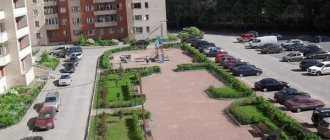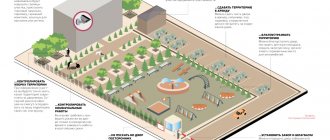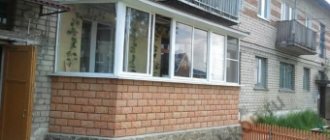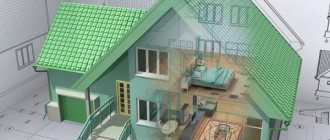Parking a car is required in accordance with the established list of rules and regulations. Any violations in this area may result in liability and penalties. There are several legislative acts that regulate all the main issues related to parking spaces in the courtyard of a residential building. Additionally, from January 1, 2021, a new order of the Ministry of Transport comes into force, tightening the requirements for commercial transport. The rules must be followed by all persons, since violations lead to a large number of negative consequences.
The legislative framework
The Housing Code of the Russian Federation provides that the owners of premises in an apartment building (apartment building) also own common property, including the land plot on which the building is located and some area around it (Article 36). The same regulatory legal act contains a mention that the local area is the land in the immediate vicinity of the building that belongs to all residents in accordance with their shares in the common property.
Government Decree No. 491 dated August 13, 2006 (as amended on September 13, 2018) states that the boundaries of such a site, including landscaped and green elements, are determined on the basis of information from the Unified State Register of Real Estate, if cadastral registration of the land was carried out. If it is not formed, then the territory belongs to the municipality. In each specific case, the size and boundaries of the land plot are individual.
In 2021, there is no law prohibiting parking in the local area in the courtyard of an apartment building. On the contrary, citizens, according to the Civil Code, have the right to freely stay on land plots that are not closed to public access (Article 262) and use common property.
Penalties for incorrect placement of a car
In the courtyard of the house you can often see how the car is located on the lawn. The Code of Administrative Offenses does not provide for punishment for parking in this place. However, regional acts reflect measures of responsibility for this act.
For example, in St. Petersburg, vehicle owners pay a fine for an incorrectly parked car in the amount of 3,000 to 5,000 rubles. Information about the established penalties for the subjects is reflected on the information stand in the administration of a particular municipality.
If a citizen observes such a violation on the part of his neighbor, this fact can be recorded using a photo or video camera, and then transferred to representatives of local authorities. In addition, you can call the administration number and report that the driver parked the car incorrectly in the courtyard of residential buildings.
What to do if your car is blocked in the yard
The owner of a car who blocks the passage of another vehicle commits a violation of Art. 12.19 Code of Administrative Offenses of the Russian Federation. In this situation, a penalty of 2,000 rubles is applied.
An exception is provided for cities of federal significance. For these territories, the fine is 3,000 rubles. The violation must be recorded in a photo/video or call the traffic police duty station and call a squad to the scene.
However, you should initially try to resolve the issue when contacting the owner of the car. Often those who block other people's vehicles leave a mobile phone number so that they can contact them.
Algorithm for bringing to justice
A sidewalk is a part of a street that is intended for use by pedestrians. You can park cars on the sidewalk in the courtyard of an apartment building only if the appropriate permit signs are posted.
If there are signs prohibiting parking and parking, you will have to pay a fine for placing a car in the yard. When there are no signs, this indicates that the vehicle can be parked.
When there is a violation of the provisions of paragraph 3 of Art. 12.19 of the Administrative Code, a fine of 1000 rubles is applied. For residents of federal cities, the sanction is 3,000 rubles.
When sanitary plan standards are violated, you can contact:
- fire inspection;
- engineering service;
- sanitary service;
- environmental inspection.
If a traffic violation is detected, a complaint is made to the traffic police. Currently, it is possible to send photo or video material recording the fact of an offense through the use of special resources.
Dimensions of parking space according to GOST
Order of the Ministry of Economic Development No. 792 dated December 7, 2016 established the parameters of a standard parking space:
- minimum – 5.3x2.5 m;
- maximum – 6.2x3.6 m.
There are no regulations as such regarding parking spaces in the courtyards of apartment buildings. Sanitary rules and regulations 2.2.1/2.1.1.1200-03 must be observed. In accordance with them, there must be at least 10 meters from the building to the parking lot. Open areas for up to 50 cars are allowed only if there are elements of landscaping and landscaping.
| Type of building | Minimum permissible distance depending on the number of vehicles | ||||
| less than 10 | 10–50 | 50–100 | 100–300 | more than 300 | |
| Residential building | 10 | 15 | 15 | 25 | 50 |
| Public facility | 10 | 10 | 15 | 25 | 25 |
| Medical, recreational place | 25 | 50 | Determined by sanitary inspection authorities | ||
| Establishment of the educational system | 15 | 25 | 25 | 50 | approved by the federal executive authority |
Most often, rules regarding distance from home are violated. Although, this provision is most important for the comfortable living of citizens.
How is the distance to a residential building determined?
In modern urban conditions, several criteria have emerged that serve as the main components in determining the acceptable distance from the house to the parking lot. The abundance of cars in big cities and even in small towns has led to the emergence of parking lots of different types and varying degrees of equipment.
Previous regulations concerned only places where cars were permanently or temporarily located, called a parking lot, if the vehicle was left for a long time, or a parking lot, where it could be left for a short time.
Yard parking
- Today, the concept of “parking” includes two types (underground and above-ground). But each of them can include a single-level or equipped with several levels. Multi-level above-ground ones can solve the problem of lack of parking space in apartment buildings, where car drivers are sometimes several family members. This presupposes that the inhabitants of one apartment have not one car, but two or more.
- Underground parking requires special conditions, additional equipment and compliance with fire safety rules (air purification hoods, hazard warning and fire extinguishing systems). The use of smart car parks, rooftops of multi-storey buildings or pallet areas have made the regulations for car parks even more relevant. The lack of space to park the car forces the invention of additional devices (such as lawn bars used to protect green spaces).
Placement of parking lots
Who is responsible for off-street parking?
In accordance with the general principles of organizing local self-government, provided for by Federal Law No. 131 of October 6, 2003, citizens can independently decide some issues regarding their property. Parking in the courtyards of multi-storey buildings is organized and landscaped after the approval of the vast majority of apartment owners.
To consider the issue, a general meeting of owners of premises in the apartment building is convened (Article 44 of the Housing Code). The decision is considered adopted if 2/3 votes are received in favor (Article 46 of the Code). Tenants cannot take part in voting and determine the fate of the local area, since they do not have ownership rights to the rented property.
What the sign prohibits
If you drive your car into a residential area, then get ready for quite tough and strict prohibitions. The following cannot be done here:
- learn to drive;
- overtake;
- perform a through drive to get around a traffic jam;
- stop without turning off the engine;
- exceed the speed;
- park a category C car;
- drive onto the lawn;
- play music loudly;
- violate other traffic rules;
- disrupt public order, etc.
A lot of controversy arises regarding truck parking, since they are sometimes needed in residential buildings to remove furniture, load or unload something, carry out repair work, etc.
Therefore, a number of amendments were made to the rule. This allows Category C vehicles to stop in residential areas if they have a special permit, a placard or are part of a service.
According to the rules on residential zones, certain restrictions apply here. Moreover, their list is quite impressive.
- You cannot drive at a speed exceeding 20 km/h;
- Traffic priority is always on the side of pedestrians and cyclists;
- It is prohibited to use the yard as a pass-through area when it is not necessary;
- There are restrictions on U-turns that can be made;
- If there is an intersection inside the zone, pedestrians are allowed through first, and only then other cars in accordance with traffic regulations;
- Restrictions also apply to driving in reverse gear;
- It is highly undesirable to perform any dangerous maneuvers and not observe the principle of interference on the right.
The restrictions cannot be called strict, since in most cases you will not have to pay a fine for them. But any potentially dangerous maneuvers cause the driver to be held accountable under other points and rules. In some of them you can lose your rights.
Through traffic is strictly prohibited in residential areas.
Unfortunately, traffic regulations do not define the concept of through traffic. But, applying the principles of interpretation of law, we can say that it is a movement through the life of law without stopping and without the intention of having the goal of movement specifically in the life of life. Most often, the purpose of through traffic is the desire to shorten the route, the reluctance to participate in a traffic jam or congestion, etc.
In ZhZ, training driving is strictly prohibited.
The motive here is clear: an inexperienced driver (not even a driver yet, according to traffic regulations) in a residential area may not orient himself in time and cause harm to both pedestrians and vehicles parked closely in courtyard parking lots.
According to traffic regulations, parking of vehicles with the engine running is prohibited in a residential area.
This is an important environmental issue. The favorable human habitat is disturbed by the smell of burning, fuel and lubricants, etc. Therefore, the legislator has limited parking.
Question. Winter is coming and drivers will be faced with the problem of having to warm up the engine in severe frost. What to do if parking with the engine running is prohibited? How to combine two needs:
- Do not ruin the power unit, which can “knock” after starting to move without warming up.
- Don't break traffic rules.
It's simple. The rules prohibit PARKING the vehicle, not stopping. Therefore, to warm up the engine, the driver has at least a 5-minute head start to bring the engine temperature to operating temperature and then start driving.
According to the rules in ZhZ, it is prohibited to park vehicles with a permissible maximum weight of more than 3500 kg outside the areas indicated by signs and/or markings.
This restriction applies to parking of category C trucks. The requirement is explained:
- on the one hand, the large dimensions of such vehicles;
- on the other hand, the limited space in the residential area, which is not enough even for numerous passenger cars belonging to citizens living in the residential area.
Consequently, for parking heavy trucks, the residential area is equipped with a special area equipped with markings or signs.
Parking rules
SanPiN prohibits parking a car at a distance of less than 10 meters from the house. If we are talking about a truck, then at least 50 m is required. In general, the traffic rules do not say much about parking in the courtyards of residential buildings. Prohibited:
- for the vehicle to stand for more than five minutes with the engine running;
- stop in a landscaped area;
- park on the lawn, flower beds, playground;
- leave the car in the driveway or near trash cans.
All this complicates movement in the yard and worsens the appearance of the area, negatively affecting the environmental situation.
Fines and sanctions
And now for many the most important part of our story. Namely, a section with fines that drivers face if they violate the rules that apply to the validity of the residential zone sign in question.
It is worth highlighting several main points in this regard:
- Violating the speed limit, the driver will pay according to the standard fine scheme;
- If you drive in a residential area at a speed of over 100 kilometers per hour, you can say goodbye to your license;
- Violating the rules of priority, the fine can range from a modest 500 rubles to a more impressive 3 thousand rubles;
- If you enter or exit a residential area incorrectly, the fine can be about 1,500 rubles;
- With the rules of parking and stopping, everything is as standard as in the traffic rules for ordinary roads;
- When you stop on the lawn, you can pay a different amount. This depends on a number of factors. In Moscow, for example, it is 5 thousand rubles.
Violations of traffic rules in indoor areas are subject to a fine of 1,500 rubles. But if you broke the rules in St. Petersburg or Moscow, the amount doubles.
Someone will say that such rules can be violated, because in Russia no one monitors residential areas, they are not patrolled. In fact, this is true. But do not forget that eyewitnesses may report your violation, film everything on camera, or provide evidence in the form of recordings from surveillance cameras. As a result, the fine may come completely unexpectedly and for a large amount. Namely, this even threatens with deprivation of rights for up to 6 months.
Now each of you will think twice before stepping on the gas inside the yard or trying to get around a traffic jam through a residential area.
What is the difference between a parking lot and a parking lot?
To understand this, you should be guided by the norms of the Town Planning Code and the Traffic Rules. In the first case, the car is placed into storage “automatically”, and in the second, the owner of the place is not responsible for it. Let's figure out what else the law says about parking and parking.
Parking is a place (usually along roads, in various spaces of the road network, in areas near buildings) for placing a vehicle in a disabled state for a short period of time (clause 21, article 1 of the Town Planning Code and clause 1.2 of the Traffic Regulations). In courtyards it is free.
Parking is a territory or premises for long-term storage of a car on a paid basis (clause 2 of the Rules for the provision of parking services, approved by Decree of the Government of the Russian Federation No. 795 of November 17, 2001). Often these are covered garages and structures. Responsibility for this lies with the site employee.
When parked, the vehicle and property in the cabin are always under surveillance. But it costs much more than even paid parking. Parking is only possible in specially designated areas, and violation of the rules may result in a fine. A garage and a covered area are also considered parking. Here the car is protected from precipitation, and its appearance is maintained in good condition. Often parking is organized in the courtyards of administrative buildings or apartment buildings. They are necessary for citizens to leave their car during the working day or at night, make purchases or visit a guest.
Travel speed
As follows from clause 10.2. The rules state that in populated areas, motorists can drive at a speed of no more than 60 km/h.
Of course, the presented restriction applies if there is no prohibiting indicator 3.24. If there is such a sign, the citizen must drive at a speed no higher than that indicated on the sign.
But for a residential area this general rule does not apply. The same clause 10.2. The rules stipulate that in a residential area, the speed of cars should not exceed 20 km/h.
Please note that other rules imposed by Section 10 of the Rules also apply to the residential zone.
For example, clause 10.1. indicates that the motorist is obliged to drive the car at a speed that takes into account the condition of the vehicle, cargo, road and weather conditions, visibility, etc.
In this case, the selected speed limit must comply with the possibility of constant monitoring of vehicle movement in order to comply with the requirements of the Rules.
For example, if there is heavy rain or fog outside, in a residential area you need to move at a much lower speed than the maximum allowed by the Rules.
How to organize parking in the local area
After a corresponding decision has been made at the general meeting of residents, which is reflected in the minutes, the site should be allocated to common shared ownership. In order for the organization of parking in the local area to be successful, it is better to appoint an initiative group in advance, which will go through the authorities.
HOA is an element of self-government that allows you to agree on what will be carried out. After agreement with the residents, interaction with local authorities begins.
Where to get permission
With the minutes of the meeting, you should contact the district land resources and land management authority (committee or department) with a request to allocate a plot for a parking lot. The application must reflect general information about the HOA, the applicant and the surrounding area. When permission is received, an application should be made to the traffic police and the architectural committee (department) of the municipality.
Procedure for drafting
To develop it you will have to hire a specialist. He will develop a project, draw a plan on how to arrange a parking lot near the house for a car. After agreement with the owners, you can begin to develop the territory. It can be limited by a barrier and equipped with an alarm. Security guards are often hired.
Design features for disabled people
Seats for persons with disabilities are marked in a special way and marked with a sign. The width of the platform is at least 3.5 m. This is explained by the reduced maneuverability of people with disabilities and the need to open the doors without interference when exiting the cabin.
Preparation of necessary documentation
The application should be accompanied by the minutes of the general meeting at which the decision to create a parking lot was made, and a certificate of the composition of the local area obtained from the Department of Inventory and Real Estate Valuation.
Tatyana Nikolaevna, hello! Thanks for the quick response.
Tatyana Nikolaevna, hello! Thanks for the quick response. The neighbor's house is 70 cm from my fence. Their wall is blank. Yesterday they made a large window in this wall, higher than our fence. What articles can you refer to when going to court?
This will be a claim “On the elimination of obstacles in the use of residential premises or land.” You need to look at the documents. You need to contact lawyers, prepare and file a claim first.
SNiP 30-02-97* Planning and development of territories of gardening dacha associations of citizens, buildings and structures (with Amendment No. 1)
6.7* The minimum distances to the border of the neighboring plot for sanitary conditions should be:
from a residential building (or house) - 3;
from construction for keeping small livestock and poultry - 4;
from other buildings - 1 m;
from the trunks of tall trees - 4 m, of medium-sized trees - 2 m;
from the bush - 1 m.
The distance between a residential building (or house) and the border of a neighboring plot is measured from the base of the house or from the wall of the house (in the absence of a base), if the elements of the house (bay window, porch, canopy, roof overhang, etc.) protrude no more than 50 cm from wall plane. If the elements protrude by more than 50 cm, the distance is measured from the protruding parts or from their projection onto the ground (cantilever roof canopy, second floor elements located on poles, etc.).
When erecting outbuildings on a garden (dacha) plot, located at a distance of 1 m from the border of an adjacent garden plot, the roof slope should be oriented towards your plot.
Once upon a time, the minimum distances between houses were not observed in any way. And we know very well that this often led to devastating fires, sometimes destroying the largest cities in the world.
The distance between houses in the city also has its own standards.
Over time, people developed certain construction principles to ensure the same safety. The fire-prevention distance between houses allows you to localize a single fire and prevent it from spreading to several buildings. This is the first thing.
Secondly, the SNiPs and GOSTs adopted in our country make it possible to maintain sanitary gaps between buildings. All this is necessary so that neighbors do not block each other’s light, and special services can easily gain access to underground communications and reduce the spread of infections.
Today there are several standards for private and multi-apartment construction. The obligation to comply with them falls on the shoulders of the developer - an individual or an association of individuals. The practice is that in an urban environment the requirements are stricter and their implementation is checked more clearly. And in country and individual construction, some minor violations are allowed.
Parking arrangement
The developed project should not contradict traffic rules, safety criteria, SanPiN and other requirements. It is necessary to take into account the norms of parking spaces for residential buildings in terms of their number, size and distance from the building. Violation of parking or stopping rules can lead to liability in the form of detention of the vehicle or a fine - from 500 to 5,000 rubles (part 1 of article 27.13, article 12.19, part 4 and part 5 of article 12.16, part 1 of article 12.10 Code of Administrative Offenses of the Russian Federation). But landscaping the area near the house, if agreed upon with the municipality and the traffic police, will not cause problems.
Installation of a video surveillance system
Parking lots can be equipped with cameras, usually around the perimeter. The situation is monitored using a computer or mobile device. The registers are kept by the responsible owner or concierge. If problems arise, residents can request records, including for transfer to government agencies.
Traffic regulations requirements for traffic in a residential area
Section 17 of the traffic rules is entirely devoted to the movement of vehicles in residential areas. What requirements are imposed on the driver when driving through such areas?
1. The maximum permissible speed in a residential area is 20 km/h. The motivation for such a restriction is clear: in a residential area there is heavy traffic of pedestrians (especially minors). High speed here is a prerequisite for hitting pedestrians.
2. Pedestrians in a residential area can move not only on sidewalks or roadsides, but also along the entire width of the roadway. This requirement is justified by the fact that the residential area is actually a “sleeping area”, so pedestrians are a common occurrence here.
3. In ZhZ, pedestrians have priority in traffic, and vehicle drivers are required to give way to them. Everything is logical, but, however, there is only one exception. Pedestrians do not have the right to create unreasonable interference with vehicles.
For example, if children draw with chalk on the asphalt, then when a car approaches, they must give the driver the opportunity to pass.
What is a spontaneous parking
Some citizens neglect the established rules and arrange parking spaces for themselves without permission. Some install posts, chains, blockers, etc. Others park the car on the sidewalk, on the lawn, or in the sandbox. Those who abandon cars in the courtyards of high-rise buildings, in green areas or on the roadway will face proceedings and fines.
Sanitary standards for distances between houses and buildings
The distance between private houses and buildings is indicated in SNiP 30-02-97* and SP 53.13330.2011. Sanitary standards take into account:
- Free passages.
- Shading.
- Water drains.
- Noise.
- Smells.
For distances from one to another residential building on an individual housing construction site, the reference point is the protrusion of the base or the projection of the balcony. In this case, the distance between the windows of residential buildings should be maintained - 6 m. This applies to both rural and urban buildings.
Livestock sheds (pig pens and chicken coops) can disturb neighbors with noise and odors. The minimum distance to them is set from the windows and is at least 12 m.
Likewise, buildings on adjacent properties should not obscure windows or the ground on the other side of the fence. The fence between sites is regulated by local authorities based on SNiP. It should not be higher than 1.5 m. Transparency - at least 50%. In some areas, the height is determined to be up to 1.2 m and transparency is 75% or higher.
You cannot plant tall trees in front of your neighbors’ windows, or install billboards or other installations that block your view, even if the windows overlook your property. Also, do not forget about the maximum height of the fence between areas.
For bathhouses, saunas and other washing facilities, the distance to the fence and other objects takes into account their specifics:
- the distance between the house and the bathhouse is 8 m;
- from the neighbor's fence - 1 m.
The distance between adjacent baths should be 4 m. Outbuildings can be connected in pairs along the border of the plots. In this case, it is necessary to ensure that runoff and rainwater do not fall into the neighboring territory. The roof slope should overhang no more than 50 cm, or it should be sloped so that water drains in its area.
The drainage hole, where the water used in the bathhouse flows, is dug at a distance of 4 m from the neighbor’s fence. If there is a bathroom under the same roof as the bathhouse, the cesspool should be located at a distance of 12 m from the windows of the neighbor’s house in accordance with SanPiN.
Drawing up and filing a complaint
Which officials will consider the owners’ applications depends on the nature of the problem. More often than not, the case does not go to court. If illegal parking occurs in the yard, it is up to the residents themselves to decide where to complain:
- district police officer;
- to the local administration;
- to the police.
An application is drawn up in free form. The consideration takes place according to the general rules established by the Code of Administrative Offenses of the Russian Federation. A specific owner or an authorized person on behalf of the HOA can apply.
Private housing construction
Individual housing construction is the main field for the operation of most laws. Since such construction does not require knowledge of legal subtleties from the developer (unlike professional builders involved in planning apartment buildings). Therefore, anyone can make a mistake.
Today, individual projects can be divided into 2 large areas:
- Actually, individual construction itself on plots allocated for individual housing construction.
- Non-commercial plots on which housing can also be built (partnerships, DNO, SNK, cooperatives, etc.).
The main difference in the first case is the presence of a police address at the property, plots for individual housing construction are given specifically for the construction of permanent buildings and year-round, rather than seasonal, residence in them, and the availability of communications.
It is easier to build housing in non-commercial areas. Often the areas of their plots are quite small, so sometimes it is simply impossible to comply with all existing standards. Based on this, the basic procedure is regulated in the charter of the company to which the site belongs.
But with individual housing construction it is more difficult. There are many requirements to be met here. The main ones are outlined:
- In the town planning code.
- SNiP 30-02-97 (as amended in 2021).
- SP 53.13330.2011.
- SNiP 2.07.01-89.
Of course, fire safety standards are of paramount importance in all these acts. In a nutshell, a distance of at least 15 meters must be maintained between a wooden building and a wooden structure. If in both cases (meaning neighbors) we are talking about brick buildings, then the minimum distance between houses can be at least 6 meters.
The red line is of great importance - marking the border with public territory and neighboring areas. Most standards require at least maintaining a 6-meter distance from the house to the red line. The fence can be removed beyond its operation, but not block access to communications (if they are laid in a common area), not interfere with pedestrians, and not obscure neighboring areas.
Inform
The rules for parking in courtyards suggest that residents of the house must be aware of the decision of the regional authorities to build a paid parking lot in the courtyard of their house. To be more precise, the following information should be published one month before the facility is put into operation:
- Reasons why parking arrangements are simply necessary.
- Designation of the territory on which it will be located.
- Date of commissioning of the facility.
- The procedure for providing the service, including the amount of payment.
How can we ensure that paid parking exists legally? Who exactly will be able to use the paid service and under what conditions? Are benefits possible for anyone? How to pay for using a parking space? Who is responsible for illegal parking and where to complain?
Who has a chance to receive certain benefits?
The rules for parking in yards assume the presence of federal or regional beneficiaries. Who can park for free:
- Heroes of Labor.
- Veterans.
- Disabled people.
- Mothers of many children.
- Law enforcement and security officials. For example, police officers, firefighters, ambulance workers and others.
Please note: all these categories of citizens can carry out parking activities free of charge only if they have properly issued permits. Also, the owner of the parking lot can, at his discretion, establish a certain category of people who can use the services free of charge.
Distance to service facilities
In addition to sanitary standards for the construction of apartment buildings, SanPiN provides additional sanitary zones for buildings that are classified as local service facilities:
These are all enterprises aimed at serving the population, where residents of the microdistrict come 2-3 times a week. The width of the sanitary zone to a residential building should be 50 m.
The distance between the store and the residential building must be maintained, regardless of its number of floors. The sanitary zone is considered not only from the basement to residential buildings, but also the area for unloading cars that constantly bring goods is taken into account.
When determining distances to a residential building in the private sector, courtyards and plots are not taken into account. For example, a store placed between wooden houses can be located from the fence of any of them to a passage width of 5 m. This norm is valid for both SNT and individual housing construction.
The distance to the base of a brick house must be at least 50 m. If there is a barn, garage or other permanent structure on the site, the distance is determined from it.
Who exactly receives the income from the organization of paid parking?
The funds received as a result of the operation of the parking lot can accumulate in the account of an individual entrepreneur (or legal entity), that is, it all depends on whose jurisdiction the land plot is located. For example, if the owners are residents of an apartment building, then all income will go directly to the account of this housing cooperative or homeowners association. And then the money is distributed depending on needs. If the owner of the land plot is a municipality, then all income from the parking lot is transferred to the local budget.
Where and how to complain?
If the parking rules in the yard are violated, you can write a complaint to:
- Traffic police A resident of the house or another interested person can call the road inspector himself by writing a statement (indicating the state license plates of the vehicles). It will be good if the claim is supported by evidence such as video and photography of the very moment of the violation. A traffic police officer must visit the local area, record the fact of the violation, communicate with the violator, draw up a protocol on administrative responsibility and issue a fine. Note: if a car parked illegally prevents employees of the management company from cleaning the yard, then they have every right to call a tow truck if the owner of the vehicle has not responded to multiple notifications asking to remove the car.
- SES, if the driver does not comply with Sanitary Regulations and Regulations and parks in close proximity to the windows.
- District Engineering Service.
- Fire inspection. An employee of this service has every right, having witnessed a violation of parking rules, to issue a fine to the violator. What is it about? For example, a fire has been identified somewhere in the house. Firefighters were called, but special equipment could not drive directly to the site of the fire due to the fact that someone’s car was blocking traffic.
- Environmental service of the region.








